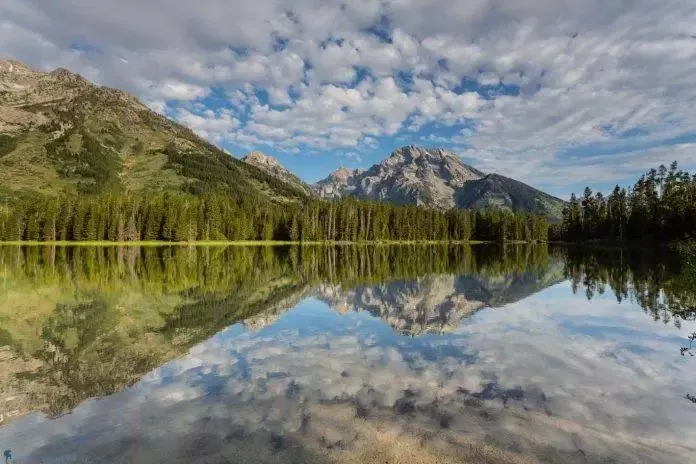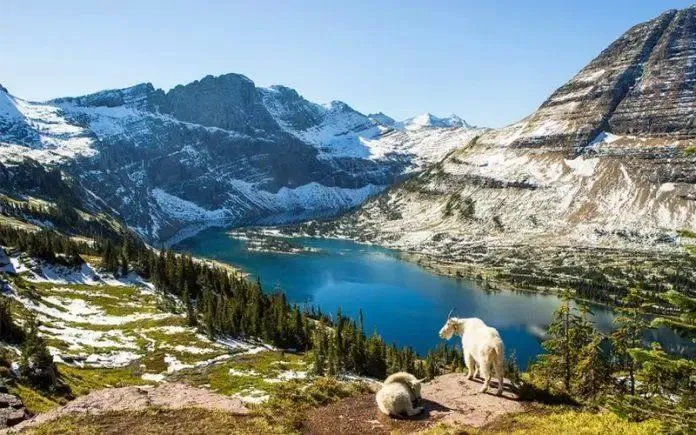Montana, nestled in the Northwestern United States, has long been celebrated as a jewel of wilderness. It’s not just a dream destination for adventure travelers, but also a rigorous yet captivating training ground for those yearning to experience primal survival instincts. With its diverse terrain, ranging from majestic mountains and vast forests to sprawling prairies, icy rivers, and crystal-clear lakes, Montana offers an endless playground for those seeking to test their limits and immerse themselves in the rhythm of nature.
Why Montana is Ideal for Wilderness Survival Experiences
Montana’s reputation as an ideal destination for wilderness survival experiences is no accident. This state boasts unique geographical and ecological features, creating an environment that is both challenging and rich with opportunities for honing and developing survival skills.
Pristine and Diverse Wilderness: Montana prides itself on its vast national forests, world-renowned national parks like Yellowstone and Glacier, and countless untouched wilderness areas. The diversity of ecosystems, from pine forests, coniferous forests, mixed forests to prairies, high mountains, rivers, and lakes, creates a rich but also challenging living environment. You may face rugged terrain, erratic and harsh weather, and the presence of dangerous wildlife.
Low Population Density: Compared to many other U.S. states, Montana has one of the lowest population densities. This means you’ll have the chance to truly immerse yourself in the tranquility and solitude of nature, far from the noise and bustle of urban life. However, it also means you’ll need to be self-reliant, with limited chances of receiving outside help in emergencies.
Abundant Flora and Fauna: Montana is home to a variety of large wildlife, including grizzly bears, gray wolves, elk, pronghorn, mountain goats, bighorn sheep, and numerous birds of prey. The diversity of wildlife not only offers opportunities for observing and learning about nature but also presents challenges in terms of safety and skills to cope when encountering them. Additionally, Montana’s rich flora provides valuable resources for food and materials to build shelters, if you know how to utilize them.
Harsh Climate: Montana has a humid continental climate, with hot summers and frigid winters. Temperatures can fluctuate dramatically between day and night, and between seasons. High mountain areas are snow-covered year-round. Weather can change rapidly and unpredictably, from warm sunshine to showers, to blizzards in just hours. This requires survivalists to be thoroughly prepared with equipment, knowledge, and skills to cope with adverse weather conditions.
Essential Survival Skills in Montana
To have a safe and meaningful survival experience in Montana, equipping yourself with basic survival skills is crucial. Here are some essential skills you need to master:
Navigation and Map & Compass Skills
In a vast and easily disorienting wilderness like Montana, navigation skills are vital. You need to know how to use topographic maps and a compass to determine your location, plan your route, and find your way back. Learn to read map symbols, determine direction using a compass and natural signs (sun, stars, moss…).
Shelter Building and Camp Setup Skills
Shelter is crucial for protecting you from harsh weather, wildlife, and maintaining body temperature. You need to learn how to choose a safe campsite, away from hazardous areas like dry riverbeds, steep slopes, and areas with dry, flammable trees. Skills in building simple shelters using natural materials (branches, leaves, mud…) or using specialized tents are also essential.
Finding and Purifying Clean Water Skills
Water is essential for survival; you cannot survive for more than a few days without it. In Montana, natural water sources are abundant from rivers, streams, lakes, and snowmelt. However, natural water can contain bacteria and parasites that cause disease. You need to learn how to find clean water sources, how to purify water using simple methods (filtering through cloth, sand, charcoal) or using specialized water filters, water purification tablets to ensure safety.
Fire Starting Skills
Fire plays a vital role in survival. Fire helps you stay warm, cook food, deter wildlife, signal for help, and provide a sense of security and morale. You need to practice various fire-starting techniques, from using lighters, waterproof matches, ferrocerium rods to primitive fire-starting methods (bow drill, fire plow…). Always have readily available tinder (birch bark, dry tinder fungus…) to easily start a fire in any weather condition.
Foraging for Food in the Wild Skills
The ability to forage for food in the wild helps you maintain energy and health for extended periods. Montana has many edible wild plants (berries, mushrooms, roots…) and small animals (fish, insects…). You need to learn how to identify edible plants and animals, how to hunt and forage safely and sustainably. However, always prioritize bringing sufficient food reserves, considering foraging in the wild as only a supplementary option.
First Aid and Emergency Response Skills
In a wilderness environment, the risk of accidents and injuries is high. You need to equip yourself with basic first aid knowledge and skills to handle situations such as wounds, bleeding, fractures, burns, hypothermia, heatstroke… Carry a personal first aid kit and know how to use it. Additionally, you also need to learn how to respond to other emergencies such as getting lost, encountering dangerous animals, and severe weather.
Dealing with Wildlife (Bears, Wolves…) Skills
Montana is home to many wildlife species, including dangerous ones like grizzly bears and gray wolves. You need to learn about the behavior of these animals, how to avoid encounters, and how to react if you encounter them. The general principle is to stay away, do not approach closely, do not feed them, and do not make loud noises that frighten them. Carry bear spray and know how to use it in an emergency.
Wilderness Survival Locations in Montana
Montana boasts many ideal areas for wilderness survival experiences. Here are a few notable suggestions:
Yellowstone National Park: Survival Challenge Beside Geothermal Wonders
Yellowstone National Park, partly located in Montana, is famous for its unique geothermal wonders such as hot springs, geysers, and mud pots. Besides, Yellowstone also has a diverse ecosystem with forests, mountains, rivers, lakes, and abundant wildlife. A survival experience in Yellowstone will give you the opportunity to explore magnificent nature while facing challenges from terrain, climate, and wildlife. Remember to strictly adhere to park safety regulations, especially in bear country.

Glacier National Park: Wilderness Survival Amidst Glaciers and Freezing Lakes
Glacier National Park, located in northern Montana, is known as the “Crown of the Continent” with its majestic mountain scenery, magnificent glaciers, turquoise lakes, and pristine forests. Glacier is a fantastic place to test survival skills in a high-altitude, cold environment. You will face rugged terrain, harsh weather, the risk of hypothermia, and wildlife adapted to high-mountain environments. Prepare thoroughly with warm gear and skills for navigating rocky terrain, snow, and ice.

Bob Marshall Wilderness: A True Survival Adventure
The Bob Marshall Wilderness, spanning over 4,000 square kilometers in western Montana, is one of the largest and least impacted wilderness areas in the United States. It features rugged mountainous terrain, pristine forests, wild rivers, and diverse flora and fauna. Bob Marshall is ideal for those seeking a true survival adventure, far from civilization, completely immersed in the wilderness. However, due to the pristine and rugged nature of the area, you need extensive survival experience and extremely thorough preparation before venturing here.
Preparing for a Survival Trip in Montana
A wilderness survival experience in Montana requires thorough preparation in all aspects. Here are some things to keep in mind:
Essential Gear
- Clothing: Choose layered clothing, warm, waterproof, and breathable materials. Don’t forget hats, gloves, scarves.
- Footwear: Specialized waterproof hiking boots with good traction.
- Tent, Sleeping Bag: Weather-resistant tent, sleeping bag suitable for expected temperatures.
- Backpack: Specialized hiking backpack, capacity suitable for the trip duration.
- Map, Compass, GPS: Navigation and guidance devices.
- Multi-tool Knife, Small Axe: Tools to assist in setting up camp, preparing food, starting fires.
- Fire Starting Kit: Lighter, waterproof matches, ferrocerium rod, tinder.
- Flashlight, Headlamp: Nighttime illumination.
- First Aid Kit: Bandages, antiseptic, personal medications, pain relievers…
- Water Filter, Water Purification Tablets: Ensure safe drinking water.
- Emergency Food: Energy bars, canned goods, dried food…
- Bear Spray: Protection against bears.
- Sunscreen, Sunglasses, Wide-brimmed Hat: Protect skin and eyes from sunlight.
- Insect Repellent: Prevent insect bites.
Plan and Notify Loved Ones
Before you go, create a detailed plan for your route, time, location, and planned activities. Share this plan with family or friends, and notify local authorities (forest rangers, police…) if you are going into remote wilderness areas. This helps ensure safety and increases the chances of timely rescue if an incident occurs.
Learn About Terrain and Weather
Thoroughly research the terrain, climate, and weather of the area you plan to visit. Learn about potential hazards such as wildlife, dangerous terrain, and severe weather. Monitor weather forecasts before and throughout your trip to be prepared for timely responses.
Physical Fitness and Skill Training
Wilderness survival experiences require good physical fitness and proficient survival skills. Train your physical fitness regularly before your trip, practice exercises to increase endurance, strength, and agility. Participate in survival skills training courses to equip yourself with the necessary knowledge and skills.
Conclusion: Conquer Montana’s Wilderness and Discover Yourself
A wilderness survival experience in Montana is not just a daring adventure, but also a profound journey of self-discovery. You will have the opportunity to train your willpower, enhance self-confidence, learn to overcome your limits, and connect with nature at a deeper level. Prepare thoroughly, respect nature, and enjoy memorable moments on your journey to conquer the challenging and captivating wilderness of Montana.